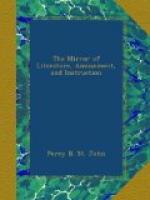THE STRAND, ANCIENT AND MODERN.
(Inscription copied from the original of the annexed Engraving.)
The Strand,
In its ancient state, anno 1547.
With the Strand Cross, Convent Garden, &c.
With the Procession of Edward VI.
The Strand,
And its Neighbourhood, anno 1700.
Looking from Arundel House, northwards,
With the Maypole and Garland.
We have often, in our antiquarian notices of the Metropolis, touched upon the olden topography of Covent garden and the Strand, and illustrated our pages with some portion of its history. Thus, in vol. xii. p. 40, the “regular subscriber” will find, an Engraving, and descriptive notes of Old Covent Garden: in vol. xiii. p. 122, he will find a second notice of the same spot; and in the same volume, p. 241, is a whole-page Engraving of the original Somerset House, with ample details of its foundation, the neighbouring district, &c. The reader should turn to these pages, and re-read them in connexion with the few particulars we have now to add.
To aid the first Engraving, with the Strand Cross and Covent Garden, we may quote that—
“Most of the ground occupied by the above parish was, in ancient times (anno 1222), an extensive garden, belonging to the Abbot and Convent of Westminster, and thence called the Convent Garden, from which the present appellation is an evident corruption. This estate, with other contiguous lands of the Abbots, which were originally named the Elms, and afterwards Seven Acres, and Long Acre, having reverted to the town at the Dissolution, was given by Edward the Sixth to his ill-fated uncle, the Duke of Somerset; after whose attainder, as appears from the original Minutes of the Privy Council, there was a patent granted in March, 1552, to John Russell, Earl of Bedford, and Lord Privy Seal, per Bill. Dom. Regis ’of the gift of the Covent, or Convent Garden, lying in the parish of St. Martin in the Fields, near Charing Cross, with seven acres, called Long Acre, of the yearly value of 6_l_. 6_s_. 8_d_., parcel of the possessions of the late Duke of Somerset, to have to him and his heirs, reserving a tenure to the King’s Majesty in socage, and not in capite.’ Shortly after, the Earl of Bedford erected a mansion, principally of wood, for his town residence, near the bottom of what is now Southampton Street;[1] and that building, which obtained the name of Bedford House, remained till the year 1704: it was inclosed by a brick wall, and had a large garden extending northward, nearly to the site of the present market-place.”




